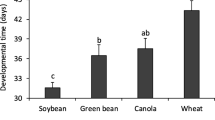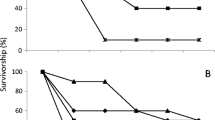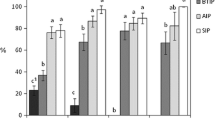Abstract
Laboratory studies with Megalotomus parvus (Hemiptera: Alydidae), feeding on seeds or pods of legumes, and on different parts of the soybean plant, Glycine max, demonstrated that nymphal survivorship, developmental time and body weight at adult emergence, and adult reproductive parameters, survivorship, longevity and body weight changes, exhibited differences depending on the food source utilized. In general, mature soybean seeds (R8 stage) were the most suitable food. The greatest nymph and adult survivorship and the greatest adult longevity were obtained from this food source. Body weight at certain ages and fecundity of females was also greater on mature soybean seeds than on the other foods. Immature soybean seeds for nymphs, and soybean pods for adults, were the second most suitable food, followed by green beans, Phaseolus vulgaris and immature lupin, Lupinus luteus seeds (for nymphs) and lupin pods (for adults); nymph and adult performance was drastically reduced on lupin seeds/pods and no nymphs survived to adult on soybean stems or leaves. On all foods tested, duration of the nymphal stages differed significantly, with the first stage being the shortest, and the fifth the longest. Females achieved significantly greater body weight than males on all foods, except on lupin pods. Results of these laboratory studies and those of field observations suggest that mature soybean seeds are the most important food source in the seasonal phenology of M. parvus
Résumé
Megalotomus parvus (Hemiptera: Alydidae) se nourrissant de graine ou de cosse de legumes et de differentes parties du soya (Glycine max) etudiés au laboratoire. Les resultats obtenus ont demontré que la survie des nymphes, la durée du developpement et le poids des adultes a l’emergence, les parametres de reproduction, de survie, longevité et le changement du poids des adultes montrent une difference qui depend de la source de nourriture. En generale, les graines de soya (R8) murs representaient l’alimentation la plus suitable. La plus importante survie ainsi que longevité des nymphes et des adultes furent avec cet aliment (graine de soya). Le poids a un age bien determiné et la fecondité des femelles étaient plus elèvés sur les graines de soya mures que les autres aliments. Les graines de soya pas murs et la cosse du soya ont été respectivement les aliments les plus suitables pour les nymphes et les adultes suivit du pois verts (Phaseolus vulgaris), les graines du lupin (Lupinus luteus) pour les nymphes et la cosse pour les adultes. La performance des nymphes et des adultes fut drasticalement reduite sur les graines et la cosse du lupin et aucune nymphe a survecu jusqu’à l’age adulte sur la tige ou les feuilles du soya. La durée du developpement des nymphes a montré une difference significative dependant du stage sur tous les aliments testés. Les femelles peuvent avoir une valeur significative plus grande que les males en se nourrissant de tous les aliments excepté la cosse du lupin. Les resultats obtenus au laboratoire et sur le terrain prouvent que les graines de soya murs sont les plus importantes source d’aliment dans la phenologie du M. parvus.
Similar content being viewed by others
References
Barber H. G. and Brimer S. C. (1947) The Coreidae of Cuba and the Isles of pines with the description of a new species (Hemiptera-Heteroptera). Mem. Soc. Cubana Hist. Nat. 19, 77–88.
Eggermann W. and Bongers J. (1971) Wasser-und nah-rungsaufnahme an pflanzen unter besonderer berücksichtigung der wirtsspezifitat von Oncopeltus fasciatus Dallas. Oecologia 6, 303–317
Fehr W. R., Caviness C. E., Burmood D. T. and Pennington J. S. (1971) Stage of development descriptions for soybeans, Glycine max (L.) Merrill. Crop Sci. 11, 929–931.
Ghauri M. S. K. (1972) Notes on the Hemiptera from Pakistan and adjoining areas. J. Nat. Hist. 6, 279–288.
Jones W. A. (1979) The distribution and ecology of pen-tatomid pests of soybeans in South Carolina. Ph.D. dissertation, Clemson University, South Carolina.
Kadosawa T. and Santa H. (1981) Growth and reproduction of soybean pod bugs (Heteroptera) on seeds of legumes. Bull. Chugoku Nat. Agric. Exp. Sta. 19, 75–97.
Kishino K. (1980) Estudo sobre percevejos prejudiciais na cultura da soja em cerrados. Rel. Pare. Proj. Coop. Pesq. Agric. EMBRAPA/CPAC/JICA, 85–127.
Muraleedharan D. and Prabhu V. K. K. (1978) Food intake and midgut protease activity in the red cotton bug, Dysdercus cingulatus Fabr. (Heteroptera: Pyrrhocoridae). Entomon 3, 11–17.
Panizzi A. R. and Herzog D. C. (1984) Biology of Thyanta perditor (Hemiptera: Pentatomidae). Ann. ent. Soc. Am. 77, 646–650.
Panizzi A. R. and Slansky, Jr. F. (1985) Legume host impact on performance of adult Piezodorus guildinii (Westwood) (Hemiptera: Pentatomidae). Environ. Ent. 14, 237–242.
Paradela F. O., Rossetto C. J. and Pompeu A. S. (1972) Megalotomus parvus Westwood (Hemiptera, Alydidae), vector de Nematospora coryli Peglion em feijoeiro. Bragantia 31, 5–10.
Schaefer C. W. (1980) The host plants of the Alydinae, with a note on heterotypic feeding aggregations (Hemiptera: Coreoidea: Alydidae). J. Kansas ent. Soc. 53, 115–122.
Schaefer C. W. and Mitchell P. L. (1983) Food plants of the Coreoidea (Hemiptera: Heteroptera). Ann. ent. Soc. Am. 76, 591–615.
Silva A. G. d’A., Gonçalves C. R., Galvão D. M., Gonçalves A. J. L., Gomes J., Silva M.N. and Simoni L. (1968) Quarto catálogo dos insetos que vivem nas plantas do Brasil-seus parasitas e predadores. Part II, Vol. 1. Minist. Agric. Rio de Janeiro.
Slansky Jr. F. (1980) Quantitative food utilization and reproductive allocation by adult milkweed bugs, Oncopeltus fasciatus. Physiol. Ent. 5, 73–86.
Slansky Jr. F. and Scriber M. (1985) Food consumption and utilization. In Comprehensive Insect Physiology, Biochemistry and Pharmacology (Edited by Kerkut G. A. and Gilbert L. I.), pp. 87–163, Vol. 4, Pergamon Press, Oxford.
Tugwell P., Rouse E. P. and Thompson R. G. (1973) Insects in soybeans and a weed host (Desmodium sp.). Agric. Exp. Sta. Rep. Series 214, Univ. Arkansas.
Villas Boas G. L. and Panizzi A. R. (1980) Biologia de Euschistus heros (Fabricius, 1798) em soja (Glycine max (L.) Merrill. An. Soc. ent. Brasil 9, 105–113.
Wilkinson J. D. and Daugherty D. M. (1967) Biology of the broadheaded bug Alydus pilosulus (Hemiptera: Alydidae). Ann. ent. Soc. Am. 60, 1018–1021.
Yonke T. R. and Medler J. T. (1965) Biology of Megalotomus quinquespinosus (Hemiptera: Alydidae). Ann. ent. Soc. Am. 58, 222–224.
Author information
Authors and Affiliations
Rights and permissions
About this article
Cite this article
Panizzi, A.R. Biology of Megalotomus parvus (Hemiptera: Alydidae) on Selected Leguminous Food Plants. Int J Trop Insect Sci 9, 279–285 (1988). https://doi.org/10.1017/S1742758400006147
Received:
Revised:
Published:
Issue Date:
DOI: https://doi.org/10.1017/S1742758400006147




